Table of Contents
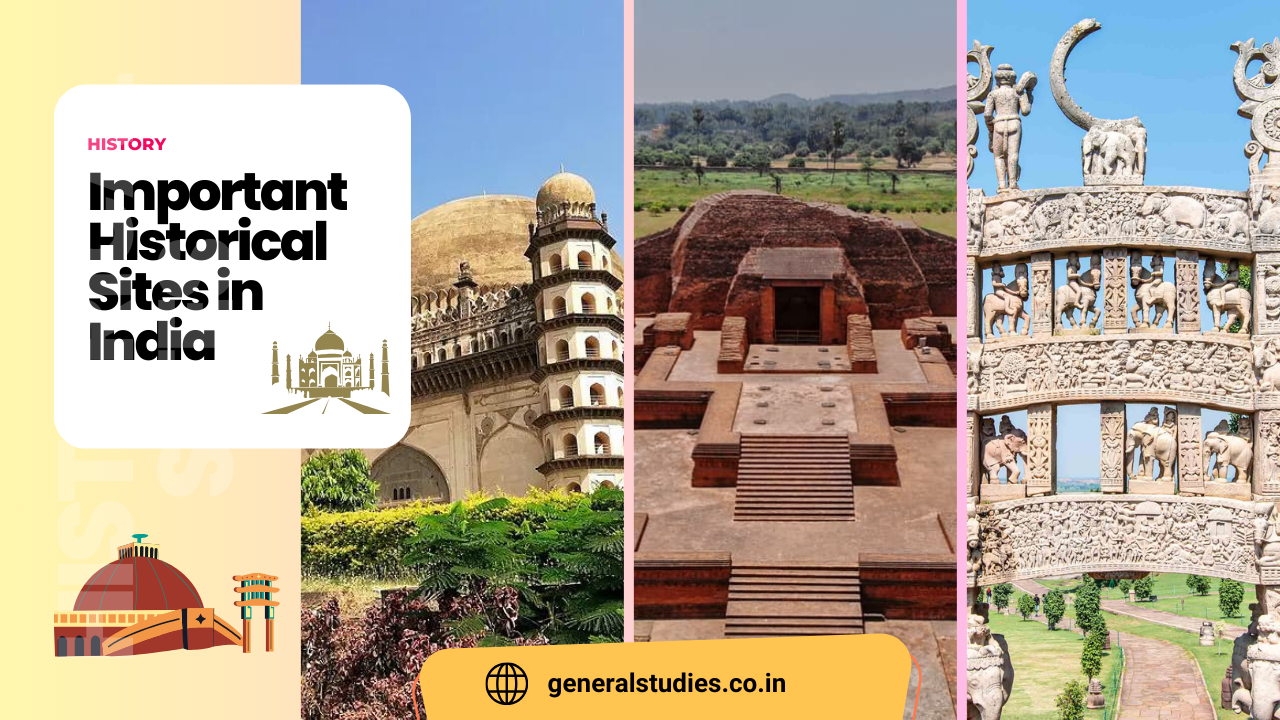
Historical Sites in India
India’s history is filled with remarkable sites that showcase its ancient civilizations, powerful empires, and cultural diversity. Understanding these historical landmarks is essential for anyone preparing for competitive exams like UPSC or PSC. In this article, we will discuss the top 10 historical sites in India, highlighting their historical importance, unique architecture, and cultural significance. Each site offers insight into different eras and rulers, helping you build a solid foundation in Indian history for your exam preparation.
Ajanta Caves (Maharashtra)
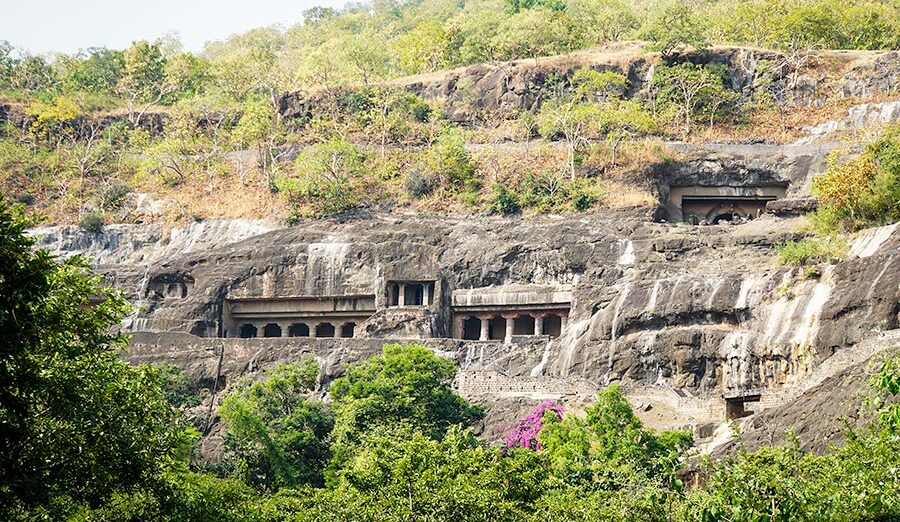
The Ajanta Caves are a group of 30 caves carved out of rock between the 2nd century BCE and 5th century CE. They are located in the Chhatrapati Sambhaji Nagar district (formerly Aurangabad district) of Maharashtra and are a UNESCO World Heritage Site.
Key Points About the Ajanta Caves:
- Art and History: The caves are famous for their beautiful paintings and sculptures. These artworks show stories about the life of the Buddha and his past lives. They are considered some of the best examples of ancient Indian art.
- Types of Caves: There are two main types of caves:
- Viharas: These were used as monasteries where monks lived.
- Chaityas: These were places for worship.
- Purpose: The Ajanta Caves were built as places for monks to live during the rainy season. They were also used by travellers and merchants as resting spots.
- Rediscovery: The caves were hidden in the jungle until 1819 when a British officer named Captain John Smith found them while hunting. Since then, they have attracted many visitors.
- Beautiful Surroundings: The caves are located in a gorge by the Waghur River, surrounded by waterfalls and lush nature, which makes them even more special.
Sarnath (Uttar Pradesh)
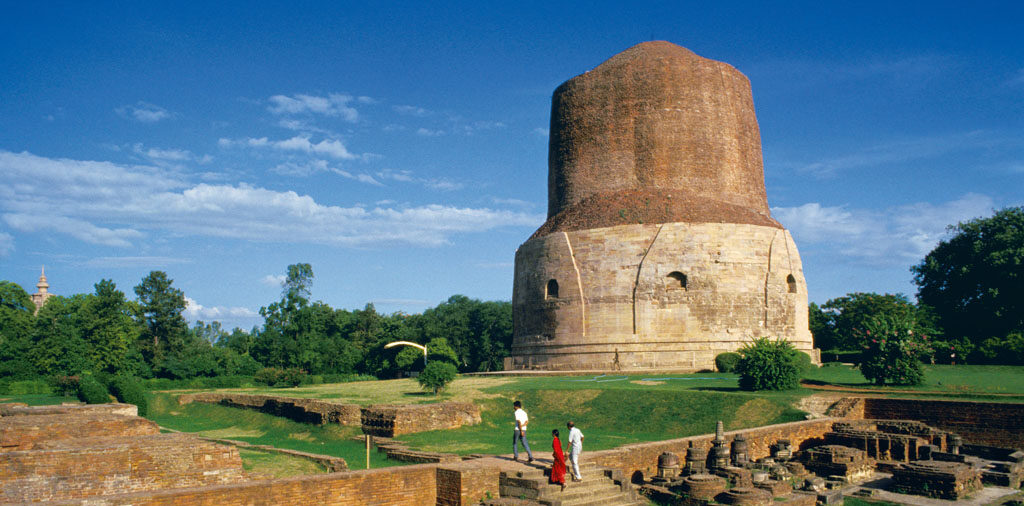
Sarnath is an important Buddhist site located about 10 kilometres northeast of Varanasi in Uttar Pradesh. It is close to where the Ganges and Varuna rivers meet.
Key Facts About Sarnath:
- First Teaching of Buddha: Around 528 BCE, after attaining enlightenment at Bodh Gaya, Gautama Buddha gave his first sermon here in Sarnath. This event is very important in Buddhism and is called the “Setting in Motion of the Wheel of Dharma.”
- Beginning of the Buddhist Sangha: Sarnath is also where Buddha’s first five followers (Kaundinya, Assaji, Bhaddiya, Vappa, and Mahanama) became enlightened, which is considered the beginning of the Buddhist community, or Sangha.
- A Place of Pilgrimage: The Buddha named Sarnath as one of four sacred places that Buddhists should visit with respect. The other three are:
- Lumbini: where Buddha was born.
- Bodh Gaya: where he attained enlightenment.
- Kushinagar: where he passed away and reached parinirvana.
- Dhamek Stupa: The Dhamek Stupa is a large stupa located in Sarnath. It is massive and cylindrical, standing around 28 meters (92 feet) tall and 43 meters (141 feet) in diameter. It has a solid stone base with intricate carvings that show a combination of Mauryan and Gupta-period architectural influences.
Khajuraho (Madhya Pradesh)
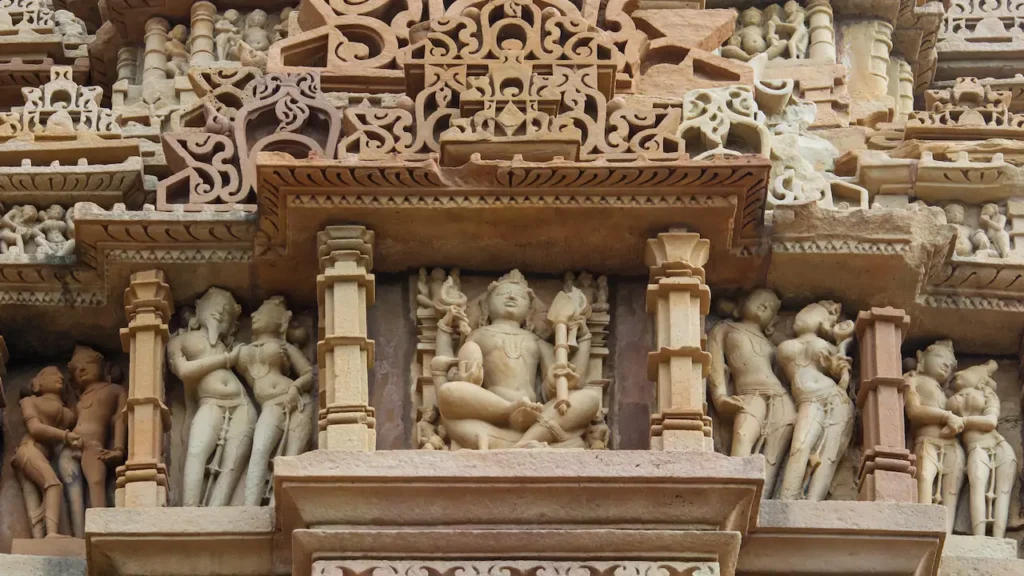
Khajuraho is a famous city in the Chhatarpur district of Madhya Pradesh, known for its beautiful temples with unique and intricate sculptures.
Key Facts About Khajuraho:
- UNESCO World Heritage Site: Khajuraho has India’s largest group of medieval Hindu and Jain temples. It is known for its erotic sculptures. The Chandela dynasty played a key role in building these temples, especially during the rule of King Dhanga (950–1002 CE). The site was declared a UNESCO World Heritage Site in 1986 and is considered one of the “seven wonders” of India.
- Meaning of the Name: The name “Khajuraho” comes from the ancient Sanskrit word “Kharjuravahaka,” meaning “date palm.”
- Rediscovery: Khajuraho declined as the Chandelas moved their centres to other forts. Some temples were damaged over time, especially during invasions. By the 16th century, Khajuraho had become a small village. It was “rediscovered” by the British military surveyor C. J. Franklin in 1819, but it was T. S. Burt, another British officer, who brought it to wider attention in 1838. Alexander Cunningham, an archaeologist, visited between 1852 and 1855 and documented the temples further.
Ellora Caves (Maharashtra)
The Ellora Caves are a major historical site in the Chhatrapati Sambhaji Nagar district (formerly Aurangabad district) of Maharashtra and are listed as a UNESCO World Heritage Site.
Key Facts About Ellora Caves:
- One of the Largest Rock-Cut Complexes: The Ellora Caves are among the largest rock-cut temple complexes in the world, featuring caves that date back to 600–1000 AD. They showcase Indian rock-cut architecture, with temples and monasteries carved into the rock cliffs of the Charanandri Hills.
- Hindu, Buddhist, and Jain Caves: The complex has over 100 caves but only 34 caves are open to the public:
- 12 Buddhist caves
- 17 Hindu caves
- 5 Jain caves
- The Kailash Temple: Cave 16 features the Kailash Temple, the largest single rock excavation in the world. This massive, chariot-shaped temple is dedicated to the Hindu god Shiva and has intricate carvings of Hindu deities and scenes from Indian epics.
- Historical Background: The caves were built primarily during the rule of the Rashtrakuta dynasty (753–982 AD) and later expanded under the Yadava dynasty (1187–1317 AD). Funding came from royalty, wealthy traders, and the local community.
- Location and Tourism: The Ellora Caves are a popular tourist destination along with the nearby Ajanta Caves and are protected by the Archaeological Survey of India (ASI).
Bodh Gaya (Bihar)
Bodh Gaya is a famous religious site in the Gaya district of Bihar, where Gautama Buddha is believed to have attained enlightenment under the Bodhi Tree.
Key Facts About Bodh Gaya:
- Significance in Buddhism: Bodh Gaya is considered the most important pilgrimage site for Buddhists. It is one of four main sites associated with Buddha’s life, along with:
- Lumbini: his birthplace.
- Sarnath: where he gave his first sermon.
- Kushinagar: where he attained parinirvana (passed away).
- The Mahabodhi Temple: The Mahabodhi Temple complex marks the exact spot of Buddha’s enlightenment. In 2002, this temple became a UNESCO World Heritage Site. The temple has been a place of worship since the Mauryan period.
- Historical Challenges: In the 12th century, Bodh Gaya and nearby areas were damaged during invasions led by Qutb al-Din Aibak and Bakhtiyar Khilji of the Delhi Sultanate.
Varanasi (Uttar Pradesh)

Varanasi, also known as Benares or Kashi, is an ancient city located on the banks of the Ganges River in Uttar Pradesh. This city has a unique place in Hinduism as a centre of pilgrimage.
Key Facts About Varanasi:
- Ancient and Holy City: Varanasi is one of the world’s oldest continuously inhabited cities, with a history that dates back over 2,500 years. The city is deeply associated with Hinduism, especially with the worship of Shiva.
- Religious and Cultural Significance:
- The city’s ancient name, Kashi, relates to the old kingdom during the period of Mahajanpadas of the same name.
- Several Bhakti movement figures, like Kabir and Ravidas, were born here.
- Many famous temples are located here, including the Kashi Vishwanath Temple (dedicated to Shiva) and the Sankat Mochan Hanuman Temple.
- Ghats and Pilgrimage:
- Varanasi is famous for its ghats. The Dashashwamedh, Manikarnika, and Harishchandra Ghats are particularly important. Manikarnika and Harishchandra are known as cremation sites where Hindus bring their deceased for last rites.
- Education:
- Varanasi has been a centre for education, especially Sanskrit studies, and is home to Banaras Hindu University (founded in 1916 by Annie Besant and Madan Mohan Malviya) and Kashi Vidyapith (established in 1921).
Somnath Temple (Gujarat)
The Somnath Temple is located in Prabhas Patan near Veraval in Gujarat. It is one of the most important pilgrimage sites for Hindus. It is known as the first of the 12 jyotirlinga shrines dedicated to the god Shiva.
Key Facts About Somnath Temple:
- Ancient Origins: Although the exact date of the temple’s first construction is uncertain, it likely dates back to somewhere between the early centuries of the 1st millennium and the 9th century CE. Ancient texts like the Mahabharata and Bhagavata Purana mention Prabhas Patan as a pilgrimage site.
- Reconstruction After Destruction: The Somnath Temple was destroyed and rebuilt several times throughout history. One of the first recorded attacks was by Mahmud Ghazni in 1026 CE.
- Post-Independence Reconstruction: After India gained independence, Vallabhbhai Patel, India’s first Deputy Prime Minister, led efforts to rebuild the Somnath Temple in the Maru-Gurjara architectural style. The reconstruction was completed in 1951.
Badami (Karnataka)
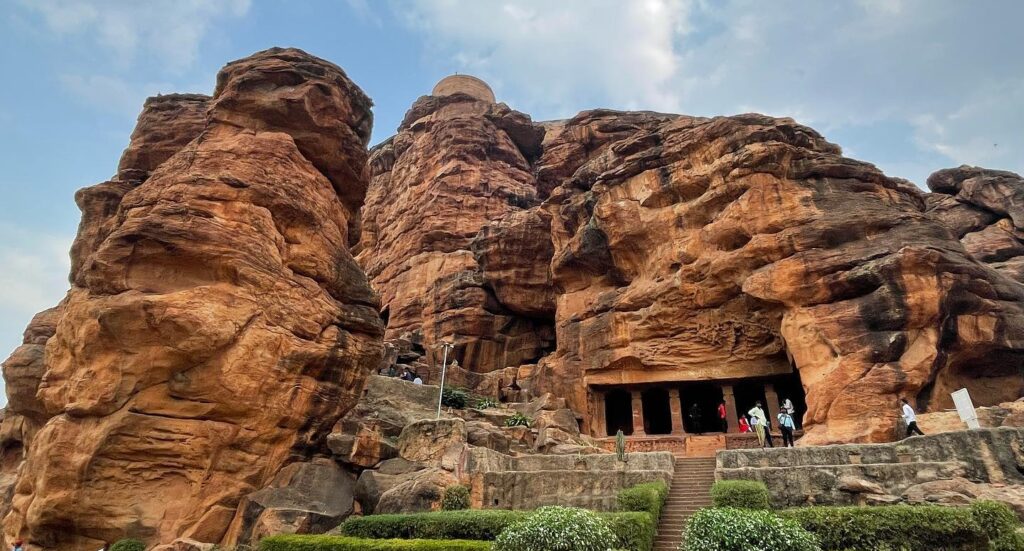
Badami is a historic town in Karnataka, India, once known as Vatapi. It was the capital of the Badami Chalukya dynasty from 540 to 757 AD. Today, Badami is famous for its cave temples and fort, located around the beautiful Agastya Lake.
Key Facts About Badami:
- Badami was founded by Pulakeshi I and later developed by his son Kirtivarman I, who built many temples and other structures. His brother Mangalesha completed the cave temples.
- The Badami Cave Temples: The Badami Cave Temples are carved directly into the red sandstone cliffs and have four main caves. Each one is unique:
- Cave I – This is a Shaivite cave, meaning it’s dedicated to the Hindu god Shiva. It features impressive carvings, including:
- An 18-armed dancing Shiva,
- Two-handed Ganesha,
- Mahishasura Mardini (the goddess Durga slaying a demon),
- Ardha Nareeshwara (a half-male, half-female form of Shiva),
- Shankarnarayana (a combined form of Shiva and Vishnu).
The ceiling has a serpent design and other carvings.
- Cave II – This cave focuses on Vishnu (Vaishnavite influence) and shows panels with:
- Trivikrama (a form of Vishnu in three giant steps),
- Bhuvaraha (a boar form of Vishnu).
The ceiling also has carvings of Anantasayana (Vishnu resting on a serpent), along with Brahma, Vishnu, Shiva, and Ashtadikpalas (the guardians of the eight directions).
- Cave III – This is the largest and most impressive cave in Badami, showing both Shaivite and Vaishnavite themes. Carvings in this cave include:
- Trivikrama,
- Narasimha (Vishnu’s half-man, half-lion form),
- Shankaranarayana,
- Bhuvaraha,
- Anantasayana,
- Harihara (a combination of Vishnu and Shiva).
An inscription here dates the creation of this cave to 578 AD by King Mangalesha, and it also has some beautifully carved pillar figures.
- Cave IV – This Jain cave, located to the east of Cave III, is dedicated to Jain figures and has:
- A large image of Mahavira (the founder of Jainism) in the sanctum,
- Carvings of Padmavathi and other Tirthankaras (Jain spiritual teachers).
- Cave I – This is a Shaivite cave, meaning it’s dedicated to the Hindu god Shiva. It features impressive carvings, including:
- Other Important Sites in Badami:
- Badami Fort – This fort is on a hilltop with granaries, a treasury, and the Malegitti Shivalaya temple believed to be the oldest temple here. It contains an old cannon placed by Tipu Sultan.
- Agasthya Lake – A large water tank near the temples, lined with several smaller temples.
Bhimbetka (Madhya Pradesh)
The Bhimbetka is an archaeological site with rock art dating back around 30,000 years. It is located in the Raisen District in Madhya Pradesh, about 45 kilometres southeast of Bhopal.
- Bhimbetka Rock Shelter:
- Bhimbetka contains approximately 760 rock shelters, of which 500 have ancient paintings.
- These shelters were home to early humans and display the development of human life and culture from hunting to agriculture.
- Some shelters may have been inhabited over 100,000 years ago.
- The rock shelters and caves of Bhimbetka contain a vast number of paintings created over thousands of years.
- It was declared as a World Heritage Site by UNESCO in 2003.
Auditorium Cave
- Auditorium Cave is one of the most remarkable rock shelters at Bhimbetka.
- It is surrounded by tall quartzite rock formations that can be seen from kilometres away.
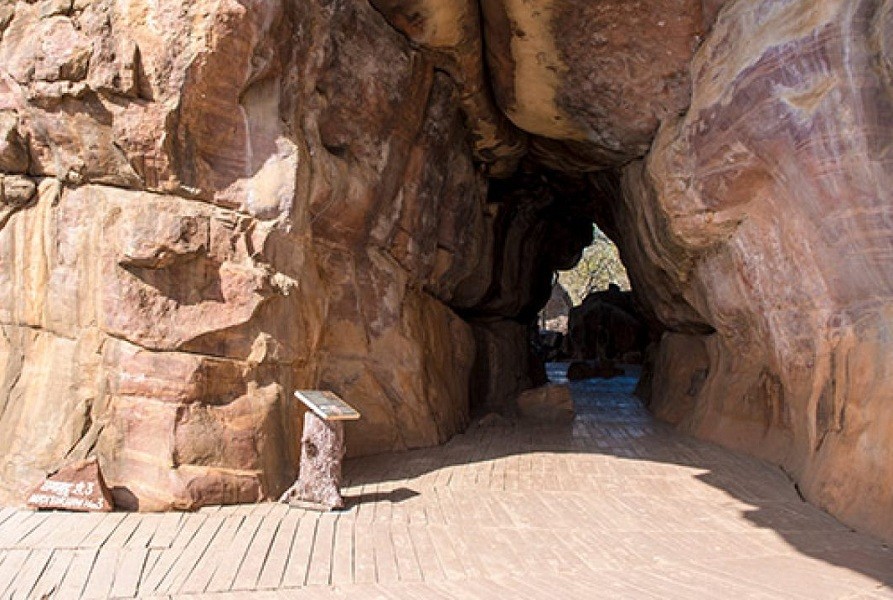
- Paintings and Art: The Bhimbetka rock shelters have a large number of ancient paintings, with some dating back to 10,000 BCE. The paintings at Bhimbetka show scenes from ancient life, including:
- Animals and Hunting Scenes: Many artworks depict animals and hunting, providing a glimpse into the Stone Age lifestyle. These paintings include people, animals, and hunting scenes, showing weapons like spears, sticks, and bows and arrows.
- Dance: Some images display dance, showing early forms of cultural expression.
- Warriors on Horseback: Likely from the Bronze Age, these paintings represent scenes from a later era.
- Red Bison: One striking painting in Bhimbetka shows an enormous red bison attacking a man, visible only when the sunlight hits it perfectly.
- Nataraj Painting: One rock shelter contains a depiction of a dancing figure with a trident-like staff, which archaeologists have nicknamed “Nataraj”.
- Geometric Designs that are simpler and less refined.
- Materials Used: Paints were made from natural materials like vegetable colours, red hematite, and charcoal.
- Connections to Other Ancient Art: The art in Bhimbetka is similar to other ancient art found globally, such as:
- Kakadu National Park in Australia,
- The Bushmen paintings of the Kalahari Desert,
- Lascaux Cave paintings in France.
Nearby Sites
- About 25 km from Bhimbetka lies Bhojpur, where you can visit a Shiva temple housing one of India’s largest shivlings at 7.5 feet tall. This temple is believed to have been built by King Bhoja.
Mahabalipuram (Tamil Nadu)
Mahabalipuram is an ancient coastal town in Tamil Nadu. It is famous for its 7th and 8th-century rock-cut temples and sculptures built by the rulers of the Pallava dynasty. As a UNESCO World Heritage Site, it showcases iconic Dravidian architecture, including the Shore Temple, Rathas, and intricate carvings depicting Hindu mythology.
- Location: Located in Chengalpattu district, Tamil Nadu, near Chennai. Known as Thirukadalmallai in ancient times.
- Historical Significance:
- Flourished as a major port city during the reign of Pallava, named after Pallava king Narasimhavarman I (also known as Mamalla).
- Became a UNESCO World Heritage Site due to its unique group of monuments and temples.
- Main Attractions:
- Shore Temple: One of India’s oldest granite temples, dedicated to Shiva.
- Descent of the Ganges: A massive open-air rock relief depicting a Hindu myth of the river Ganges descending to Earth.
- Pancha Rathas (Chariots): The Pancha Rathas (also known as Ainthinai Kovil) is a monument complex in Mahabalipuram, along the Coromandel Coast. This site exemplifies five monolithic temples named after the Pandavas (Arjuna, Bhima, Yudhishthira, Nakula and Sahadeva) and Draupadi from the Mahabharata, each carved from a single stone. These rock-cut temples were designed to resemble chariots. Originally attributed to King Narasimhavarman I (630–668 CE). Pancha Rathas is part of the Group of Monuments at Mahabalipuram, a UNESCO World Heritage Site since 1984.
- The Caves:
- A series of rock-cut temples dating back to the 7th century, including notable shrines like the Varaha, Krishna, and Mahishasuramardini caves. Notable caves include:
- Krishna Cave: Depicts Krishna lifting the Govardhan hill.
- Mahishasuramardhini Cave: Shows Goddess Durga fighting the buffalo demon Mahishasura, alongside a peaceful Vishnu in cosmic sleep.
- A series of rock-cut temples dating back to the 7th century, including notable shrines like the Varaha, Krishna, and Mahishasuramardini caves. Notable caves include:
Pattadakal (Karnataka)
Pattadakal, also known as Raktapura, is a historic temple complex located in Bagalkot district in northern Karnataka. This ancient site is known for its stunning temples built during the 7th and 8th centuries by the Chalukya kings. This historic site, nestled along the Malaprabha River, showcases a unique blend of North and South Indian architectural styles. It was designated as a UNESCO World Heritage Site.
Main Temples and Monuments
- Virupaksha Temple:
- Built by Queen Lokamahadevi to commemorate the Chalukya victory over the Pallavas.
- Dravidian-style structure with elaborate carvings, including Lingodbhava, Nataraja, and Ravananugraha.
- Known for its active status as a place of Hindu worship and its intricate sculptures.
- Mallikarjuna Temple:
- Constructed by Queen Trailokyamahadevi and similar in style to the Virupaksha Temple.
- Features detailed panels on the ceiling, depicting scenes like Gajalakshmi and Nataraja.
- Carvings depict the life of Krishna, Mahishasuramardini, and Ugranarasimha.
- Papanatha Temple:
- Located outside the main enclosure, built around 680 CE.
- Features scenes from the Ramayana and Mahabharata and marks an early experiment in northern architectural style.
- Jain Temple:
- Built in the Dravidian style along the Pattadakal-Badami Road.
- Known for its elegant 9th-century sculptures, dedicated to Jain teachings.
- Galaganatha Temple: Constructed in the northern Rekhanagara style with a sculpture of Shiva defeating Andhakasura.
- Sanghameshwara Temple:
- Likely the oldest temple in Pattadakal, built by King Vijayaditya.
- Dravidian style with notable sculptures of Ugranarasimha and Nataraja.
- Kadasiddeshwara Temple: Built in the northern style, featuring Shiva with a serpent and trident alongside Parvati.
Cultural Significance and Festivals
- Banashankari Temple Festival: Celebrated annually near Badami in January-February.
- Virupaksha Temple Car Festival: Held in Pattadakal in March.
- Mallikarjuna Temple Festival: Takes place in Pattadakal during March-April.
Historical Places in India at a Glance
Will be uploaded soon.
